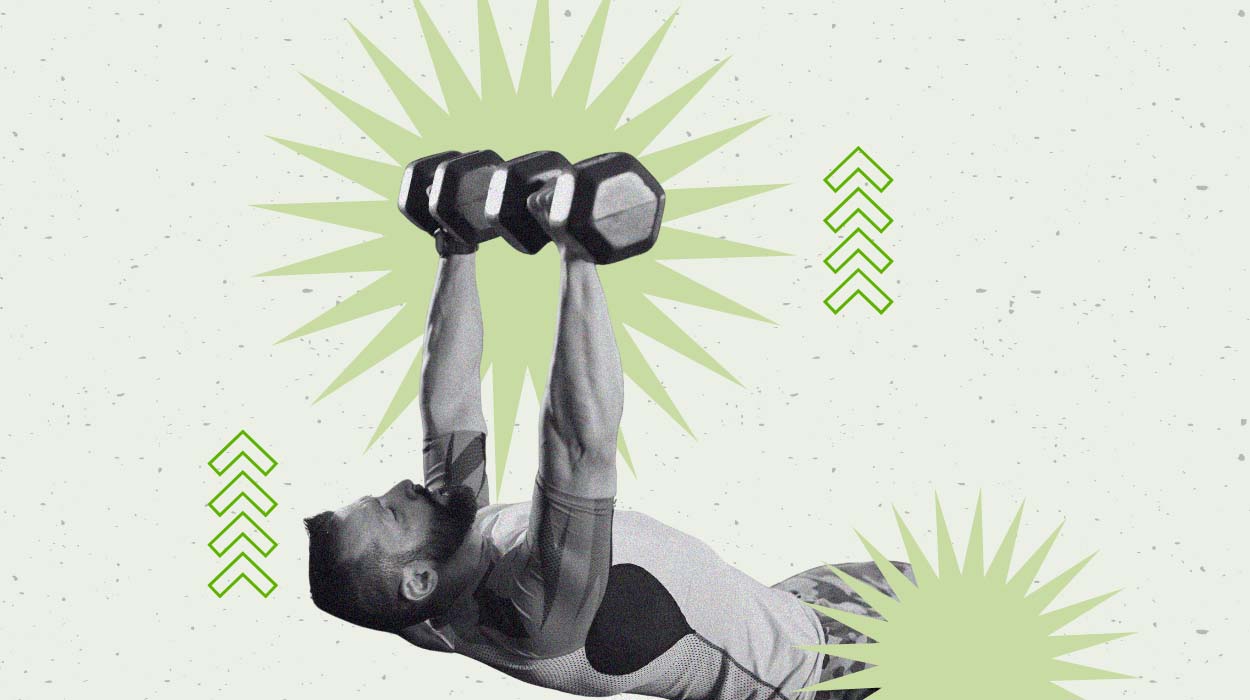
Toning your muscles to improve your physique is about including dynamic, effective exercises that align with your lifestyle, regardless of whether you have access to the gym. Take, for example, a dumbbell chest workout that doesn’t require a bench. This form of exercise highlights the importance of flexibility and adaptability in your fitness routine.
You can effectively activate and strengthen your pectoral muscles without a bench enhancing both your physical strength and aesthetic appeal. Integrating these healthy habits can serve as one of the simplest, yet most effective strategies when figuring out how long it takes to lose weight. Let’s delve deeper into the transformative power of such workouts and explore their contribution to your holistic fitness journey.
Dumbbell Chest Workout Without Bench
A dumbbell chest workout without a bench utilizes exercises like:
- Standing Dumbbell Chest Press
- Dumbbell Floor Press
- Dumbbell Svend Press
- Dumbbell Pullover
- Dumbbell Push-Ups
to target pectoral muscles,[1] requiring minimal equipment and can be done at home.
These workouts help in enhancing muscle activation, balance, and coordination, and correct muscle imbalances. Chest dumbbell exercises offer benefits such as safety, versatility, and convenience with an increased range of motion, promoting balanced muscle development and reducing injury risk.
Five Dumbbell Chest Workout Without Bench
Each exercise offers a powerful way to build and strengthen your chest muscles, even without a bench. They emphasize safety, muscle engagement, and versatility, contributing effectively to your fitness journey. As always, it is crucial to maintain correct form and consistent effort to achieve the best results.
The key to getting results lies in selecting the right exercises that maximize muscle engagement and promote overall strength and growth. Here are some of the best no-bench dumbbell chest workouts, characterized by their simplicity, effectiveness, and safety:
Standing Dumbbell Chest Press
This exercise effectively targets the pectorals and engages your core for stability, providing a comprehensive upper-body workout and helping you to achieve the flat stomach you desire.
How to do:
- Stand with your feet hip-width apart, holding dumbbells at chest level with your elbows bent.
- Lift the dumbbells to shoulder height, with your palms facing forward and elbows bent at a 90-degree angle.
- Press the dumbbells straight up, extending your arms fully. Lower them back down with control, bringing the elbows to a 90-degree angle. Keep your core engaged and maintain a slight bend in your knees throughout.
- Inhale as you lower the dumbbells and exhale as you press them up. Focus on a smooth, controlled movement to maximize chest muscle engagement.
Tips:
- Ensure a stable stance by planting your feet firmly on the ground. This provides a strong base and allows you to generate power through your legs and core.
- Emphasize a controlled tempo during both the upward and downward phases of the press. This not only maximizes muscle activation but also reduces the risk of straining your shoulder joints.
- Choose a weight that challenges you but allows for proper form. Adjust the resistance as needed for each set to ensure you can complete the recommended sets and reps with good technique.
Optimal Sets And Reps: 3 sets for 8-12 reps per set.
Dumbbell Floor Press
Lie on your back, knees bent, and feet flat. With a dumbbell in each hand, perform a chest press with your elbows resting on the floor, engaging the muscles for a focused upper-body workout.
How to do:
- Keep your feet flat and core engaged for a stable base, ensuring proper form and maximizing the effectiveness of the floor press.
- Maintain control over your elbow positioning, preventing them from flaring out. This minimizes stress on the shoulder joints while emphasizing chest activation.
- Aim for a full range of motion by lowering the dumbbells until your elbows gently touch the floor. This enhances muscle engagement and promotes flexibility in the shoulder joint.
Tips:
- Keep your wrists in a neutral position, avoiding excessive bending or hyperextension. This ensures proper alignment and reduces the risk of wrist discomfort during the exercise.
- Coordinate your breathing, inhaling as you lower the dumbbells and exhaling as you press them up. This helps maintain focus and control and enhances overall performance.
- Choose a weight that challenges you without compromising your form.
Optimal Sets And Reps: 3 sets for 8-12 reps per set.
Dumbbell Svend Press
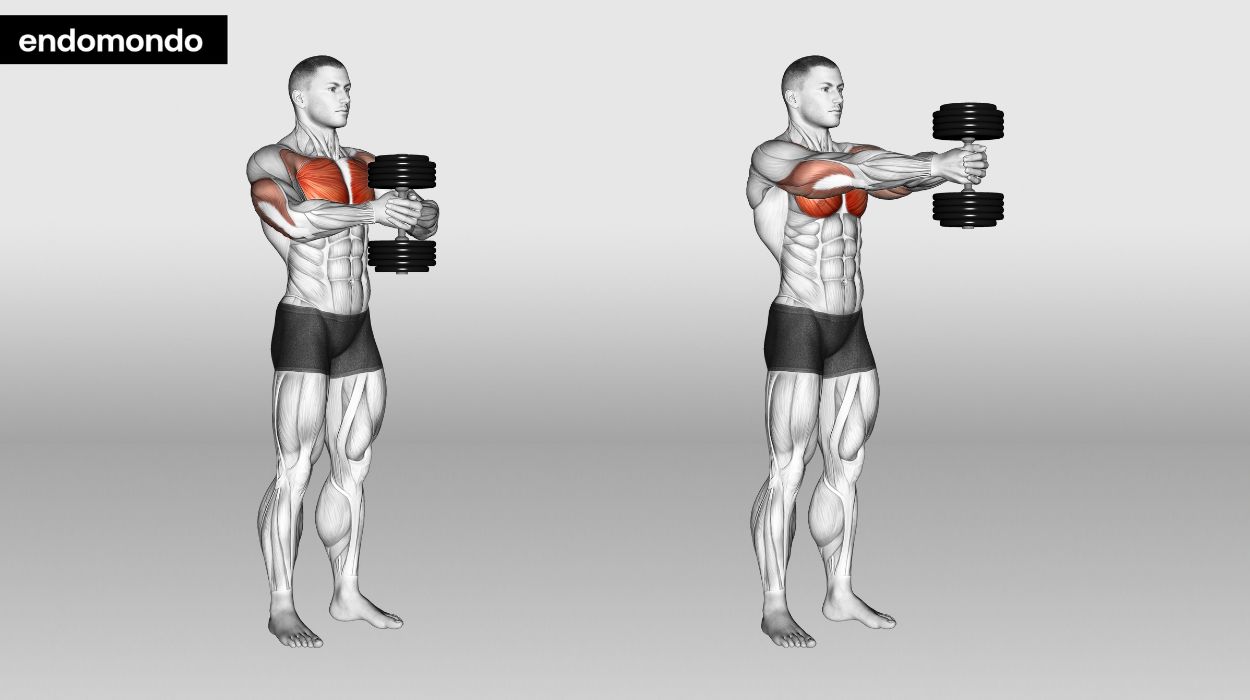
The Dumbbell Svend Press is an excellent exercise to target the chest and engage the inner pectoral muscles. This unique variation adds a dynamic element to your chest workout, promoting strength and definition.
How to do:
- Holding one dumbbell with both hands in front of your chest, squeeze the weight together.
- Press the weight out in front of you until your arms are fully extended. Be sure to squeeze the dumbbell throughout the movement.
- Slowly return to the start position. This exercise targets the inner chest muscles, helping to develop the often-neglected pectoral minor.
Tips:
- Throughout the movement, maintain a constant squeeze between the dumbbells.
- Focus on a controlled press, avoiding any sudden jerks or bouncing. This ensures that your chest muscles are consistently under tension, maximizing the benefits of the exercise.
- Coordinate your breath with the movement, exhaling as you press the dumbbells together. Develop a strong mind-muscle connection by concentrating on the chest contraction, amplifying the engagement of the targeted muscles.
Optimal Sets And Reps: 3 sets for 10-15 reps per set.
Dumbbell Pullover
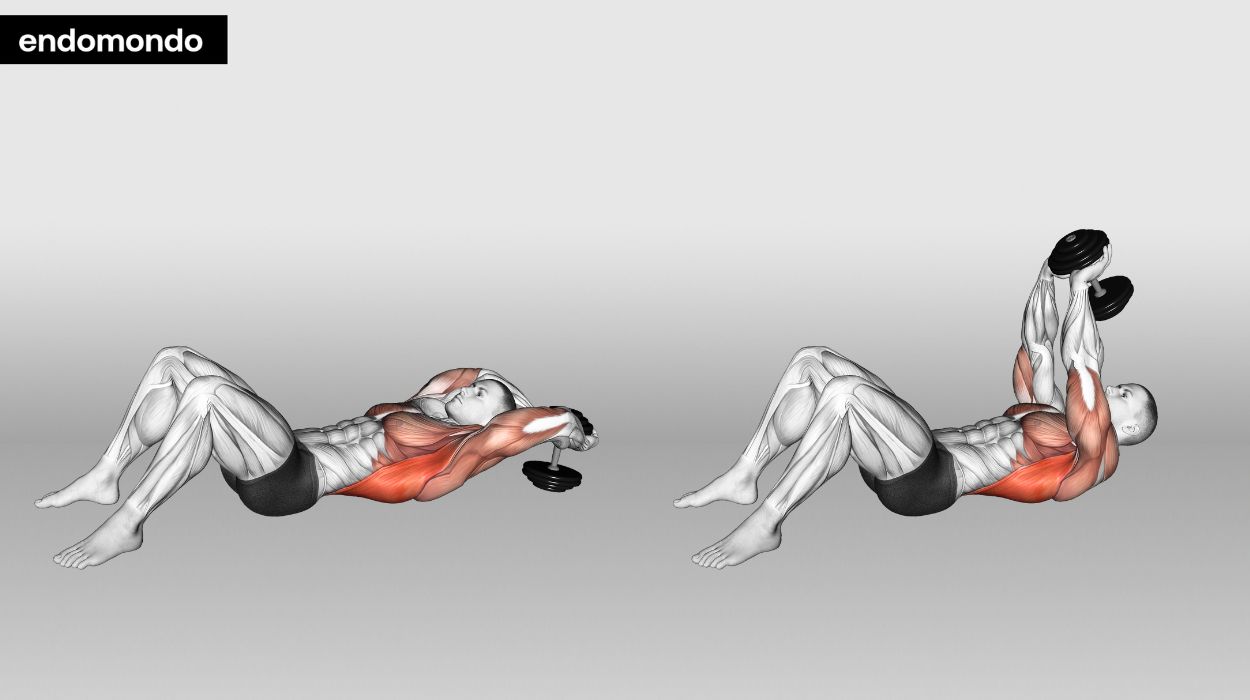
The Dumbbell Pullover is a versatile exercise that targets the chest, back, and core muscles. This exercise effectively targets the upper chest and back muscles, promoting better posture.
How to do:
- Lying on the floor with your knees bent, hold a single dumbbell over your chest with both hands.
- Slowly lower the weight behind your head, then pull the weight back over your chest.
- Return to the starting position by engaging your chest and lats.
Tips:
- Focus on a controlled and deliberate movement throughout the exercise. Avoid overextending your range of motion to prevent strain on the shoulders and maintain optimal muscle engagement.
- Keep your core muscles engaged and your lower back pressed into the bench. This provides stability and protects your spine during the pullover, allowing for effective muscle targeting.
- Inhale deeply as you lower the dumbbell and exhale forcefully as you bring it back to the starting position. Coordinating your breath with the movement enhances overall control and concentration.
Optimal Sets And Reps: 3 sets for 10-12 reps per set.
Dumbbell Push-Ups
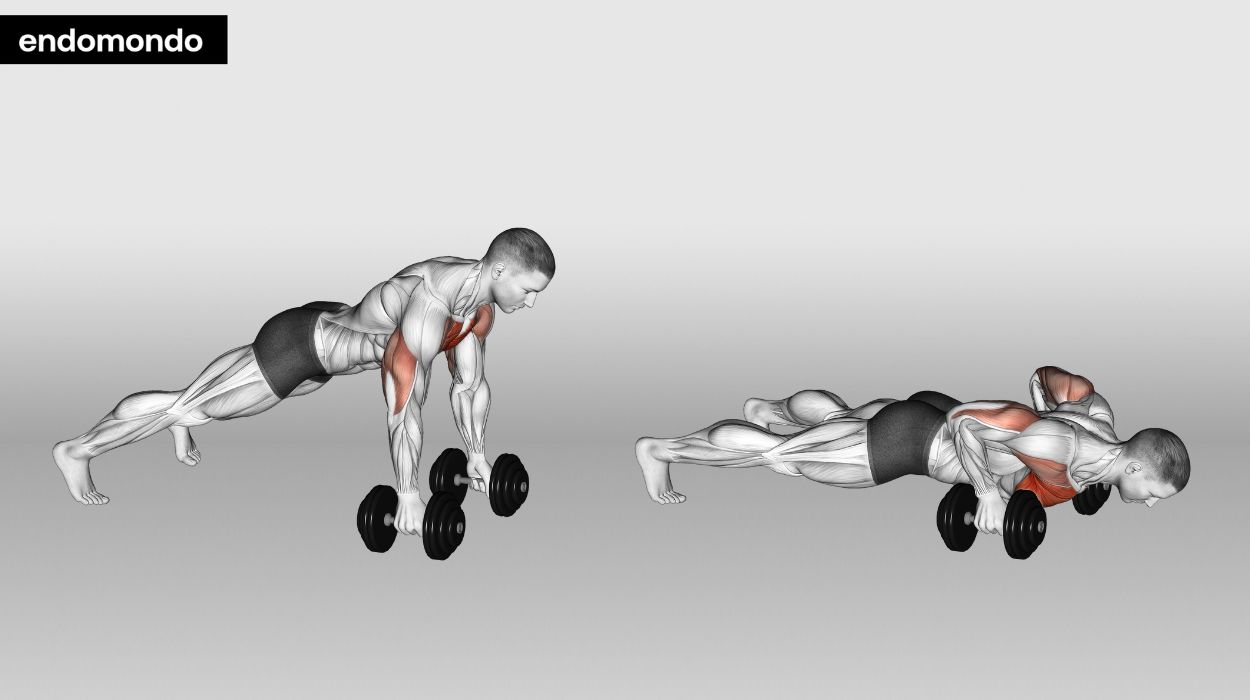
Dumbbell Push-Ups add an extra dimension to traditional push-ups, intensifying the challenge on your chest, shoulders, and triceps. This exercise is excellent for building upper body strength and stability.
How to do:
- Start in a traditional push-up position with a dumbbell in each hand.
- Lower your body towards the floor, maintaining a straight line from your head to your heels, then push back up to the starting position.
Tips:
- Keep your wrists in line with your shoulders to avoid unnecessary strain.
- Tighten your core throughout the movement, stabilizing your body and preventing your lower back from sagging. This ensures proper form and maximizes the engagement of your chest and triceps.
- Emphasize a controlled tempo during both the descent and ascent of the push-up. This not only enhances muscle activation but also reduces the risk of joint stress, promoting a safer and more effective workout.
Optimal Sets And Reps: 3 sets for 10-15 reps per set.
What Is A Dumbbell Chest Workout At Home Without Bench?
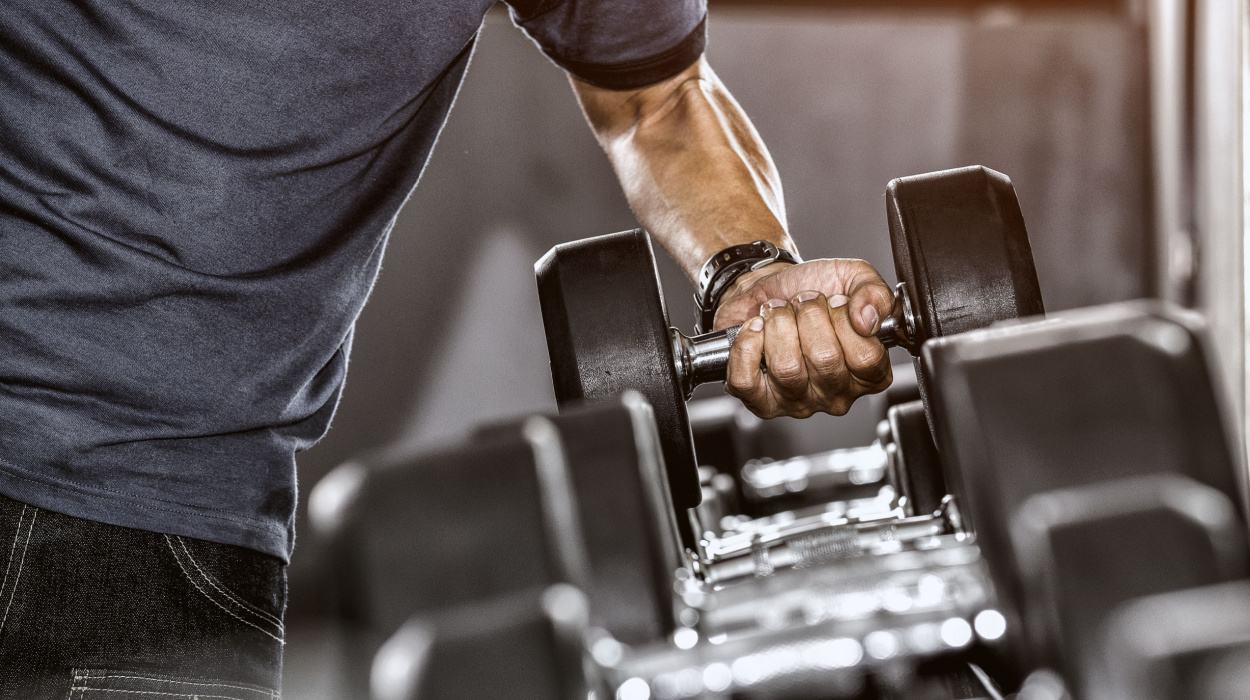
While most gym-based exercises center around a bench, dumbbell chest workouts can be done just as effectively without one. The workouts above are designed to effectively engage and strengthen the pectoral muscles without the need for a bench or other traditional gym equipment.
These types of chest dumbbell[2] workouts without the use of a bench are best for anyone who doesn’t have access to a full gym. This is because they require minimal equipment and can be performed at home while standing or lying on the floor. They’re also beneficial for improving balance, and muscle imbalances, and reducing the risk of injury due to the higher range of motion included compared to traditional bench exercises.
Benefits Of Chest Dumbbell Exercises Without Bench
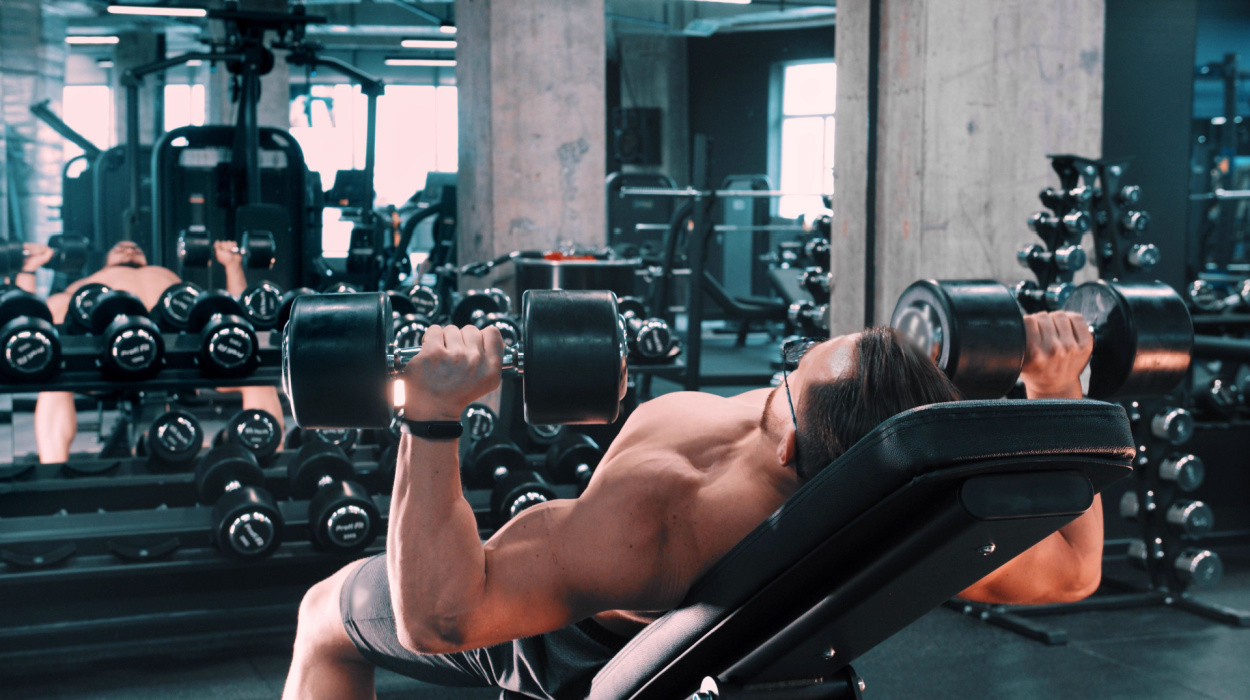
Working out your chest with dumbbells provides an effective, versatile, and safe approach to muscle growth and strength enhancement. It’s an excellent choice for both gym-goers and home workout enthusiasts, offering a broad spectrum of exercise possibilities and benefits.
Enhanced Muscle Activation
Using dumbbells, as opposed to barbells or fixed gym machines, results in greater muscle activation. Dumbbell exercises stimulate higher muscle activation in the pectoralis major – the primary chest muscle.
This is primarily because dumbbells demand greater stabilization and recruit more muscle fibers than other exercise equipment.
Convenience
The availability of certain gym equipment should not limit workouts. Dumbbells offer a wide array of exercise possibilities even without a bench.
For instance, standing chest presses, floor presses with dumbbells, deep push-ups with dumbbell pick-ups – all these exercises challenge your pectoral muscles and can be easily performed at home or in any convenient space.
Better Muscle Development
During purposeful exercises, a larger number of muscle fibers are being recruited and activated. This can lead to increased muscle activation, better muscle development, and ultimately, greater strength gains.
Studies show “that high-intensity[3] resistance training stimulates greater improvements in some measures of strength and hypertrophy in resistance-trained men during a short-term training period.” This wider range enables deeper muscle fiber engagement, encouraging superior growth and strength over time.
Unilateral Strength Balance
One of the significant advantages of dumbbell exercises is their ability to decrease strength imbalances. This is because each limb is required to move independently and control its weight.
Research[4] has reported that unilateral exercises, like those performed with dumbbells, can effectively address and correct muscle imbalances. This leads to balanced muscle development on each side, improved functional strength, and a reduced risk of injury.
Extended Range of Motion
Dumbbell workouts offer an increased range of motion compared to barbell-based exercises. This increased range allows for more profound engagement of the muscle fibers, leading to enhanced muscle hypertrophy and growth. For example, exercises like dumbbell flies allow the arms to move in a wider arc, stretching the pectorals more than a barbell bench press would.
Adaptability
Dumbbells, by their very nature and design, are highly versatile and adaptable to various workouts and settings. With a simple pair of dumbbells, you can perform a comprehensive set of exercises that target every section of the chest muscles. This enables a well-rounded chest workout tailored to your needs and fitness levels.
Enhanced Safety
Dumbbell exercises can be safer than barbell workouts when performed with proper technique and form. In a scenario where the lifter struggles with the weight during a rep, dumbbells can be dropped independently, reducing the risk of being pinned under a heavy barbell. This feature especially benefits those who prefer to work out alone without a spotter.
Space Conscious
Dumbbells are more space-efficient than many other types of gym equipment, making them a convenient option for home workouts. This accessibility allows you to maintain your fitness routine from the comfort of your home, breaking down the barriers to a consistent exercise regimen.
Conclusion
These various no-bench dumbbell chest workouts enhance muscle activation, promote unilateral strength balance, offer an increased range of motion, and can be done almost anywhere.
In the fitness realm, adaptability is key. With a pair of dumbbells and the right technique, a robust and rewarding chest workout can be accomplished anywhere, anytime. Remember, the path to fitness is not limited by gym equipment but enhanced by our ability to innovate and adapt.
Frequently Asked Questions
Absolutely. Exercises such as the standing dumbbell chest press, dumbbell floor press, and dumbbell pullover can effectively target and strengthen chest muscles without needing a bench.
Yes, especially without a bench. Exercises like dumbbell floor press limit the range of movement, reducing the strain on your shoulder joints and enhancing workout safety.
Dumbbell exercises require more muscle stabilization than machine or barbell exercises. This increased demand helps improve overall balance and coordination.
Yes, unilateral exercises performed with dumbbells can effectively address and correct muscle imbalances, as each limb works independently.
Absolutely. The versatility and convenience of dumbbell workouts make them ideal for at-home fitness routines.
This depends on your fitness goals, but typically, it’s beneficial to include dumbbell chest exercise in your routine 2-3 times a week.
It’s best to start with a weight you can lift with proper form for 10-15 reps. Over time, gradually increase the weight as your strength improves.
Resources
- Baig, M.A. and Bordoni, B. (2023). Anatomy, Shoulder and Upper Limb, Pectoral Muscles. [online] Nih.gov. Available at: https://www.ncbi.nlm.nih.gov/books/NBK545241/
- Ferreira, D.V., Ferreira-Júnior, J.B., Soares, S.R.S., Cadore, E.L., Izquierdo, M., Brown, L.E. and Bottaro, M. (2017). Chest Press Exercises With Different Stability Requirements Result in Similar Muscle Damage Recovery in Resistance-Trained Men. PubMed, [online] 31(1), pp.71–79. doi:https://doi.org/10.1519/jsc.0000000000001453.
- Mangine, G.T., Hoffman, J.R., Gonzalez, A.M., Townsend, J.R., Wells, A.J., Jajtner, A.R., Beyer, K.S., Boone, C.H., Miramonti, A.A., Wang, R., LaMonica, M.B., Fukuda, D.H., Ratamess, N.A. and Stout, J.R. (2015). The effect of training volume and intensity on improvements in muscular strength and size in resistance-trained men. Physiological Reports, [online] 3(8), pp.e12472–e12472. doi:https://doi.org/10.14814/phy2.12472.
- Behm, D.G., Muehlbauer, T., Armin Kibele and Urs Granacher (2015). Effects of Strength Training Using Unstable Surfaces on Strength, Power and Balance Performance Across the Lifespan: A Systematic Review and Meta-analysis. Sports Medicine, [online] 45(12), pp.1645–1669. doi:https://doi.org/10.1007/s40279-015-0384-x.




